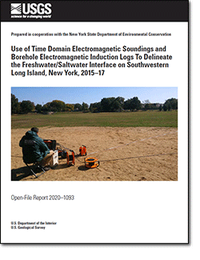Use of Time Domain Electromagnetic Soundings and Borehole Electromagnetic Induction Logs to Delineate the Freshwater/Saltwater Interface on Southwestern Long Island, New York, 2015–17
Links
- Document: Report (3.02 MB pdf)
- Data Release: USGS data release (html) - Time domain electromagnetic surveys collected to estimate the extent of saltwater intrusion in Nassau and Queens County, New York, October–November 2017
- Database: Database (html) - USGS GeoLog Locator
- Download citation as: RIS | Dublin Core
Abstract
The U.S. Geological Survey, in cooperation with the New York State Department of Environmental Conservation, used surface and borehole geophysical methods to delineate the freshwater/saltwater interface in coastal plain aquifers along the southwestern part of Long Island, New York. Over pumping of groundwater in the early 20th century combined with freshwater/saltwater interfaces at the coastline created saltwater intrusion in the upper glacial, Jameco, Magothy, and Lloyd aquifers. This study documents, for the first time, extensive saltwater intrusion of the Lloyd aquifer along the southwestern coast of Long Island, N.Y. Several public-supply wells in the southern parts of Nassau, Queens, and Kings Counties have been adversely affected by saltwater intrusion causing supply wells to be shutdown and abandoned. Due to the ongoing groundwater pumping in southern Nassau County, the freshwater/saltwater interface requires delineation and monitoring for any inland movement.
In 2015–17, the U.S. Geological Survey collected time domain electromagnetic soundings at 12 locations and borehole electromagnetic induction conductivity logs at 9 wells within the study area to delineate several saltwater intrusion wedges. The upper glacial, Jameco, and Magothy aquifers were grouped into one aquifer complex within the study area to simplify interpretations. The coastal plain sediments increase in thickness from west to east and north to south because of their regional dip toward the southeast. Three separate wedges, shallow, intermediate, and deep, of saltwater intrusion were delineated in the upper glacial, Jameco, and Magothy aquifer complex. In addition, analysis of geophysical logs collected in an open borehole of a test well in southern Queens County in 1989 revealed the Lloyd aquifer was nearly completely intruded by saltwater with an estimated chloride concentration of 15,000 milligrams per liter. The geophysical logs from this well provides, for the first time, definitive proof of saltwater intrusion of the Lloyd aquifer on Long Island’s south shore, suggesting the freshwater/saltwater interface was at the coastline and not miles offshore as theorized by previous studies.
Suggested Citation
Stumm, F., Como, M.D., and Zuck, M.A., 2020, Use of time domain electromagnetic soundings and borehole electromagnetic induction logs to delineate the freshwater/saltwater interface on southwestern Long Island, New York, 2015–17: U.S. Geological Survey Open-File Report 2020–1093, 27 p., https://doi.org/10.3133/ofr20201093.
ISSN: 2331-1258 (online)
Study Area
Table of Contents
- Acknowledgments
- Abstract
- Introduction
- Methods
- Location of the Freshwater/Saltwater Interface on Southwestern Long Island
- Summary
- References Cited
| Publication type | Report |
|---|---|
| Publication Subtype | USGS Numbered Series |
| Title | Use of time domain electromagnetic soundings and borehole electromagnetic induction logs to delineate the freshwater/saltwater interface on southwestern Long Island, New York, 2015–17 |
| Series title | Open-File Report |
| Series number | 2020-1093 |
| DOI | 10.3133/ofr20201093 |
| Publication Date | September 17, 2020 |
| Year Published | 2020 |
| Language | English |
| Publisher | U.S. Geological Survey |
| Publisher location | Reston, VA |
| Contributing office(s) | New York Water Science Center |
| Description | Report: vi, 27 p.; Data Release; Database |
| Country | United States |
| State | New York |
| Other Geospatial | Long Island |
| Online Only (Y/N) | Y |
| Additional Online Files (Y/N) | Y |


